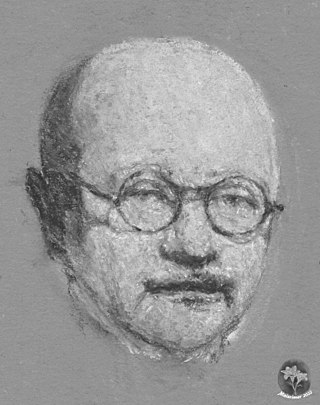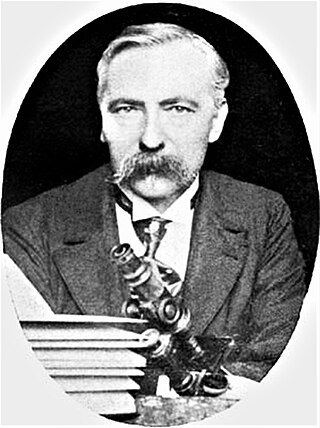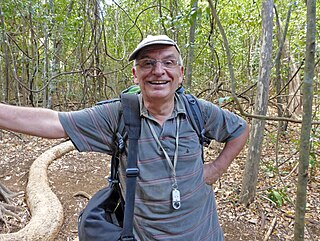
Lorenzo Romano Amedeo Carlo Avogadro, Count of Quaregna and Cerreto (, also, Italian:[ameˈdɛːoavoˈɡaːdro]; 9 August 1776 – 9 July 1856) was an Italian scientist, most noted for his contribution to molecular theory now known as Avogadro's law, which states that equal volumes of gases under the same conditions of temperature and pressure will contain equal numbers of molecules. In tribute to him, the ratio of the number of elementary entities (atoms, molecules, ions or other particles) in a substance to its amount of substance (the latter having the unit mole), 6.02214076×1023 mol−1, is known as the Avogadro constant. This constant is denoted NA, and is one of the seven defining constants of the SI.
Family is one of the eight major hierarchical taxonomic ranks in Linnaean taxonomy. It is classified between order and genus. A family may be divided into subfamilies, which are intermediate ranks between the ranks of family and genus. The official family names are Latin in origin; however, popular names are often used: for example, walnut trees and hickory trees belong to the family Juglandaceae, but that family is commonly referred to as the "walnut family".

The Boletales are an order of Agaricomycetes containing over 1300 species with a diverse array of fruiting body types. The boletes are the best known members of this group, and until recently, the Boletales were thought to only contain boletes. The Boletales are now known to contain distinct groups of agarics, puffballs, and other fruiting-body types.

Psilocybe is a genus of gilled mushrooms, growing worldwide, in the family Hymenogastraceae. Most or nearly all species contain the psychedelic compounds psilocybin and psilocin.

The Agaricaceae are a family of basidiomycete fungi and include the genus Agaricus, as well as basidiomycetes previously classified in the families Tulostomataceae, Lepiotaceae, and Lycoperdaceae.

Philippe Édouard Léon Van Tieghem was a French botanist born in Baillleul in the département of Nord. He was one of the best known French botanists of the latter nineteenth century.

Rupicapra is a genus of goat-antelope called the chamois. They belong to the bovine family of hoofed mammals, the Bovidae.
Sammarçolles is a commune in Vienne, Nouvelle-Aquitaine, France. The small town lies northeast of Loudun, 6.5 kilometres by road. It contains a "rich chapel", built by the Montault des Isles family. 686 people were recorded in 1886. The population declined in the 20th century to a low of 472 people in 1990. As of 2017 it has a population of 642 people.

Roger Heim was a French botanist specialising in mycology and tropical phytopathology. He was known for his studies describing the anatomy of the mushroom hymenium, the systematics and phylogeny of higher fungi, the mycology of tropical fungi such as Termitomyces, as well as ethnomycological work on hallucinogenic fungi, like Psilocybe and Stropharia. In his career, he published over 560 articles, scientific reviews, and major works in fields like botany, chemistry, education, forestry, horticulture, liberal arts, medicine and zoology.

Narcisse Théophile Patouillard was a French pharmacist and mycologist.

Antoine Laurent Apollinaire Fée was a French botanist who was born in Ardentes, 7 November 1789, and died in Paris on 21 May 1874. He was the author of works on botany and mycology, practical and historical pharmacology, Darwinism, and his experiences in several regions of Europe.

Lichinales is the sole order of ascomycete fungi in the class Lichinomycetes. It contains three families: Gloeoheppiaceae, Lichinaceae, and Peltulaceae. Most species are lichenized. Lichinales was proposed in 1986 by German lichenologists Aino Henssen and Burkhard Büdel. The class Lichinomycetes was created by Valérie Reeb, François Lutzoni and Claude Roux in 2004.

The Tulasnellaceae are a family of fungi in the order Cantharellales. The family comprises mainly effused (patch-forming) fungi formerly referred to the "jelly fungi" or heterobasidiomycetes. Species are wood- or litter-rotting saprotrophs, but many are also endomycorrhizal associates of orchids and some have also been thought to form ectomycorrhizal associations with trees and other plants.

The 9th arrondissement of Marseille is one of 16 arrondissements of Marseille. This district is the largest in the city. The 9th arrondissement borders the 8th, 10th and 11th arrondissements. It is governed locally together with the 10th arrondissement, with which it forms the 5th sector of Marseille.
Maurice Philippe Gaspard Beeli was a Belgian mycologist.
Jean Louis Martin Castagne was a French botanist and mycologist.

Emmanuël Sérusiaux is a Belgian lichenologist. His career, spanning more than four decades, has combined both lichenology research and political aspects of nature conservation. He spent several periods working as a researcher at the National Fund for Scientific Research and the University of Liège, the latter in which he accepted a faculty position as professor and head of the Plant Taxonomy and Conservation Biology unit. Sérusiaux also served for three non-consecutive appointments as Deputy Chief of Staff in the Government of Wallonia. He retired from both his academic and political positions in 2019.













